Imaging Earthlike Exoplanets
By Thomas Sherrill
Two space missions now under development aim to uncover sister worlds to our own
Two space missions now under development aim to uncover sister worlds to our own

DOI: 10.1511/2005.56.516
Astronomers have now discovered close to 200 planets outside the solar system. The vast majority revealed themselves through their influence on their parent stars, which wobble ever so slightly in response to the planet's gravitational pull.
The Doppler shift of spectral lines in the light from such stars shows the part of this motion that is toward or away from Earth. But this "radial velocity" method is not the only approach; several other indirect techniques have also been employed in recent years. And teams of astronomers are now beginning to make credible claims that they have obtained images of extrasolar planets ("exoplanets" for short), using both ground and space telescopes.
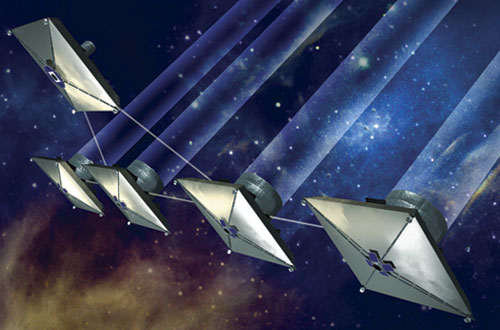
Artist’s conception courtesy of NASA/JPL-Caltech
What sorts of worlds are these? Of the long list of known exoplanets, most are believed to be gas giants. They presumably resemble Jupiter, Saturn, Uranus or Neptune, at least broadly, although some of them come in much larger sizes. A few may, in fact, be big enough that they should properly be classified as brown dwarfs (essentially failed stars). The reason for this uncertainty is that radial-velocity measurements do not show the inclination of the orbit of a putative exoplanet with respect to the observer's line of sight, which in turn means that astronomers can only set a lower limit on the mass of the body. But these results aren't necessarily evidence that planets closer to Earth in size are uncommon, because the radial-velocity technique favors the discovery of high-mass objects, in particular ones in close orbits about their parent stars. Smaller planets may be abundant too—just harder to detect.
The current roster of extrasolar planets contains only about a half-dozen objects with masses less than 20 times that of Earth. Of these, two are thought to have masses that are only about three times that of Earth. But Earthlike they are not: They orbit a 6-millisecond-period pulsar, the neutron-star remnant of an ancient supernova blast. Somehow these planets survived that cataclysmic explosion and now orbit their pulsar sun while perpetually bathed in its high-energy radiation. They must be most inhospitable worlds. Another relatively small exoplanet, 7.5 times the mass of the Earth, is likewise in an uncomfortable location, circling its star in only two days at a distance of 3 million kilometers. Its surface temperature is probably close to the melting point of lead.
Although the many dozens of gas giants discovered to date have yielded important information on the frequency and evolution of certain types of solar systems, what some planet-seeking astronomers would dearly like to do most is discover objects more like Earth. As President Bush's "new vision" for the National Aeronautics and Space Administration states, the agency should place particular emphasis on "conduct[ing] advanced telescope searches for Earthlike planets and habitable environments around other stars." The aim, of course, is to address a fundamental question that has intrigued humankind for centuries: Is there life, even primitive forms of life, elsewhere in the universe? Scientists now have the means to begin looking for the answer.

Diagram at right is adapted from Kasting et al. 1993. Illustration by Barbara Aulicino.
For example, after its discovery in 1999, a body known officially by the name HD 209458 b (informally dubbed "Osiris") became the first exoplanet to be observed crossing in front of its parent star, permitting astronomers to estimate its diameter (about 30 percent larger than Jupiter's) and its mass (about 70 percent of Jupiter's). In 2003, investigators determined that it had an extended, comet-shaped atmosphere, which last year yielded spectrographic evidence for the presence of both oxygen and carbon. Impressive as such work is, astronomers are anxious to do better. In particular, they look forward to directly imaging Earthlike planets and obtaining detailed spectra of their atmospheres, a capability that holds great promise for gauging whether life could exist on these worlds.
In searching for exo-Earths, a key factor in deciding which stars to examine is the size of their "habitable zones," regions in which the surface temperature of a typical planet would be capable of supporting liquid water over a range of pressures. The hottest main sequence stars (normal, non-giant ones) have their habitable zones located the farthest out, making them relatively easy to probe from great distances away. But these stars are short-lived and probably wouldn't survive long enough for life to evolve or for ecosystems to develop. A more sensible strategy is to examine their cooler, longer-lasting cousins, although their close-in habitable zones would require searching nearer to the glare of these stars. Mid-temperature solar-type stars, or ones slightly more massive than the Sun, would be even better bets, because these types have suitably long lives and are thought more likely to have planets.
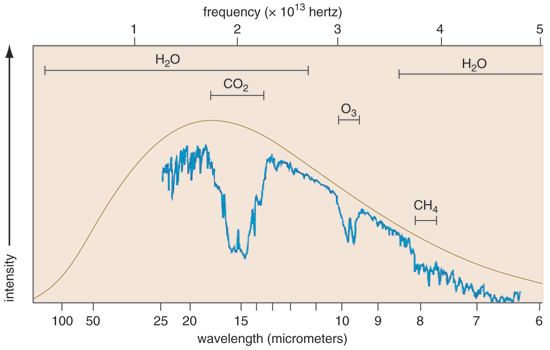
Diagram based on data from Kunde et al. 1974. Illustration by Barbara Aulicino.
Other criteria would also apply to any serious hunt for exo-Earths. One would, for example, be wise to shun binary (or multiple) systems, because a stellar companion can readily expel planets that form close to one of the stars. And the search plan should favor stars that have a high proportion of atoms heavier than helium, because the presence of these "metals" (as astronomers call them) is thought to foster the formation of planets. One would also want to avoid having to point the telescope too close to the plane of the Galaxy, where background stars are so abundant as to be confusing.
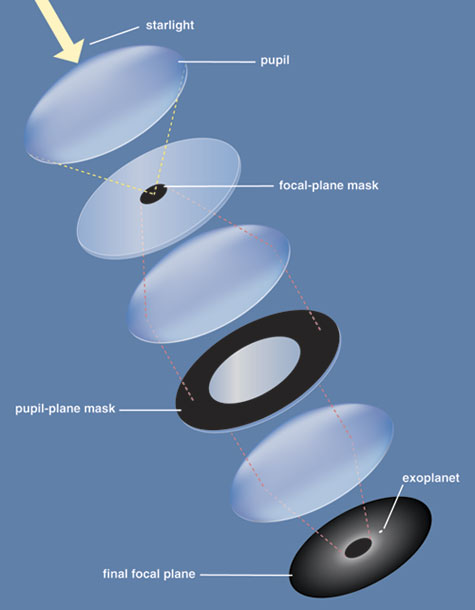
Emma Skurnick and Barbara Aulicino
The question of what instrumentation would be best suited for such a search has been a source of debate among astronomers for years. Seen from 30 light-years away, the Earth would appear 0.1 arc-second away from the Sun, which would be about 10 billion times brighter at visible wavelengths. Viewed in the mid-infrared, say at a wavelength of about 10 micrometers, the ratio is 1,000 times more favorable—but still amounts to a factor of about 10 million. And at this wavelength the Earth would appear embedded in a cloud of luminous zodiacal dust, the vestige of countless long-gone comets and broken-up asteroids. That shroud of fine particles would itself be a few hundred times brighter than Earth. Charles A. Beichman of NASA's Jet Propulsion Laboratory (JPL) has likened the problem to that of "finding a firefly next to a searchlight on a foggy night." How can one ever hope to separate the feeble light of a planet from the overwhelming glare of its parent star?
Astronomers have at their disposal two fundamental strategies, the roots of which date back many decades. The more familiar of the two calls for the use of a coronagraph, a device invented by the French astronomer Bernard Lyot in 1930 in his efforts to observe the solar corona and prominences, features that were previously only seen during total eclipses of the Sun.
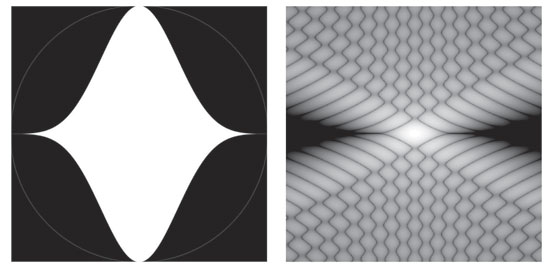
Courtesy of N. Jeremy Kasdin
A standard coronagraph uses a pair of occulting masks to block most of the face of the star while allowing light from the surrounding area to pass. Specially designed coronagraphs are being installed or are already working at several high-altitude observatories to aid in the search for exoplanets. These instruments operate at visible and near-infrared wavelengths, as well as in the handful of relatively unobscured atmospheric "windows" in the infrared region of the spectrum. Chief targets are young stars, whose gas giants would still retain a significant amount of heat from their formation, making them shine brightly at infrared wavelengths.
The current state of the art for ground-based coronagraphs is probably represented by the Lyot Project Coronagraph at the 3.6-meter Advanced Electro-Optical System telescope on Mount Haleakala on the Hawaiian island of Maui. Developed by the U.S. Air Force to track orbiting spacecraft, the telescope has perhaps the world's most sophisticated system of adaptive optics. It uses 941 electromechanical actuators to rapidly change the shape of a small deformable mirror in the light path and thereby compensate for atmospheric distortion. This coronagraph is expected to be able to detect a several-Jupiter-mass planet 400,000 times fainter than its host star and separated from it by an angular distance of only 0.2 arc-second. The Lyot Project is now undertaking a search of several hundred stars located up to 80 light-years away.
The method that is competing with such coronagraphs is called "nulling interferometry." Optical interferometry dates back even before Lyot's time, to the early 1880s, when Albert A. Michelson developed the first interferometer. He and Edward W. Morley used that apparatus in the famous Michelson-Morley experiment, an attempt to confirm the existence of the so-called ether, the hypothesized medium thought necessary for the propagation of light waves. (Michelson and Morley failed to detect evidence for the ether, a negative result of enormous significance to modern science.)
In general, an interferometer splits light from a source into two or more beams, which then travel over different paths until they are brought back together and allowed to recombine. The patterns of interference fringes that result from the superposition of the two waves can be used to make a variety of very precise measurements—of wavelength, index of refraction, distance or thickness. In astronomy, the study of the interference fringes from stellar light sources has permitted the determination of the diameters of some very large stars and the separations of binary stars that would otherwise be impossible to resolve.
Nulling interferometry is a special application of a device that Ronald N. Bracewell of Stanford University proposed in 1978 for observing extrasolar gas giants. Bracewell's scheme has the beams from two mirrors combined in such a way that light from the central star undergoes destructive interference, whereas light from an off-axis planet experiences constructive interference. In Bracewell's original conception, such an interferometer would be placed in space. But several ground observatories are now being outfitted with nulling interferometers to look for giant planets and to study disks of "exo-zodiacal" dust about nearby stars.
For example, the twin 10-meter Keck telescopes on Hawaii's Mauna Kea have been operating together as an interferometer for more than four years, and a specialized device called "the nuller" is currently being integrated into the setup. Also in development is the University of Arizona's Large Binocular Telescope Interferometer (LBTI) on Mount Graham, which in 2007 will begin seeking planets using the near-infrared light they emit. Astronomers involved with this project predict that in its star-nulling mode the LBTI will be capable of discerning a young (and therefore infrared-bright) planet that is, for example, five times the mass of Jupiter and located 30 light-years distant from Earth.
Although adaptive optics will enable ground-based facilities to observe some gas giants (say, a planet with the diameter and orbital radius of Jupiter), detecting an Earth-size object circling in the habitable zone of a nearby star requires instrumentation in space. Furthermore, determining that an exoplanet is truly Earthlike will ultimately require spectral measurements, which are understandably best collected outside of Earth's obscuring atmosphere.
The space telescopes that are currently operating—the venerable Hubble Space Telescope and the newer Spitzer Space Telescope—already have some capability for sensing gas giants about nearby stars. Hubble's Near Infrared Camera and Multi-Object Spectrograph (NICMOS) and Advanced Camera for Surveys (ACS) both have coronagraphic modes. Indeed, NICMOS produced a notable image of the suspected 5-Jupiter-mass planet recently found around the brown dwarf 2M 1207. And earlier this year the Spitzer telescope detected the warm infrared glow of the aforementioned Osiris by comparing brightness measurements of its host star while it eclipsed the planet with measurements of both star and planet before and after the eclipse.
Future astronomy missions will build on these successes. For example, both the near-infrared and mid-infrared cameras for the James Webb Space Telescope (planned for launch in 2011) will have coronagraphic devices, which will be used to obtain images and coarse spectra of massive planets. However, astronomers recognize that a space telescope capable of observing exo-Earths must be designed to even more-demanding specifications.
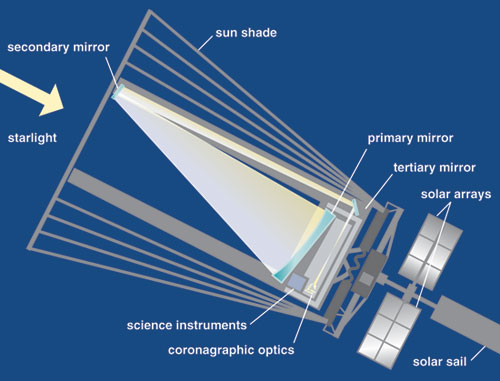
Emma Skurnick and Barbara Aulicino
How demanding? That question has taken considerable work to answer. Perhaps the first serious attempts at defining the requirements of such a mission began in 1985 when NASA's Solar System Exploration Division and the National Academy of Science's Space Studies Board each established a committee to explore various approaches. Interest in planetary searches continued to build among astronomers, and in 1996 JPL organized a study that culminated in the publication of "A Road Map for the Exploration of Neighboring Planetary Systems." That report called for the development of what was to become known as the Terrestrial Planet Finder or TPF.
At the time, this mission was conceived as using an infrared nulling interferometer, consisting of four or more 1.5-meter mirrors mounted on a roughly 75-meter-long structure. Such an arrangement could detect and characterize Earthlike planets located up to about 40 light years away. To allow colder operation of the optics (and thus reduce the instrumental background warmth that plagues infrared observations) and to diminish the impact of observing through the solar system's zodiacal dust cloud, the report recommended that the instrument be placed in a deep-space orbit, up to five times farther out than the Earth is from the Sun.
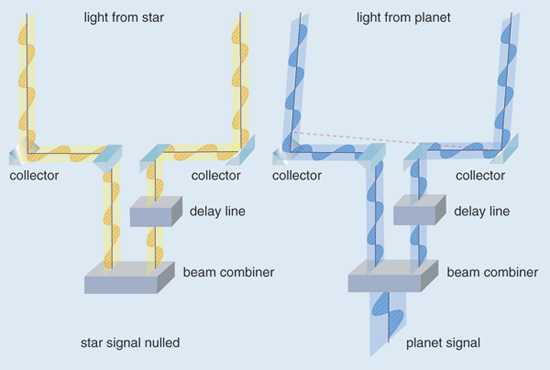
Emma Skurnick
Over the next three years, scientists and engineers at JPL built prototype equipment and further refined the initial design. Progress in the development of large, lightweight optics suggested that the 1.5-meter mirrors could be replaced by 3.5-meter mirrors, which could operate closer to Earth, avoiding the long travel time and communications difficulties of a deep-space deployment. What is more, it was decided that the four mirrors did not need to be structurally connected. Rather, the four "collector" telescopes could fly in formation around a single "beam combiner" spacecraft. This arrangement allows the flexibility to optimize the arm length of the interferometer for each target star.
Workers at JPL documented their revised TPF design in May 1999, including a description of how operations would be conducted. The basic planet search would involve surveying a couple of hundred stars within about 50 light-years' distance and scattered about the sky. Three or four observation sessions a year for each star might be required to establish that objects that appear to be planets are not really background stars and to chart the orbits of the planets discovered. More detailed observations of perhaps two or three dozen of the candidate planets would provide the spectral information needed to study their atmospheres.
To determine which exoplanets are promising enough to warrant such follow-up work, estimates of their sizes might be made based on brightness and distance from the parent star: A planet that is too small might well have lost any atmosphere it started with, whereas one that is too large might just be another gas giant. Relatively short observations (two days or so each) would suffice to obtain spectra of high enough resolution to detect carbon dioxide or water by their telltale absorption bands.
Finally, half a dozen or so of the most promising candidates for an exo-Earth would be studied in detail by obtaining spectra sensitive enough to show what may be only trace amounts of certain molecular species—those that could be indicative of habitability or even of life itself. These so-called "biomarkers" leave distinctive spectral features in the visible, near-infrared and mid-infrared regions of the spectrum. Chief among the chemical species of interest are carbon dioxide, methane, molecular oxygen and the product of its photodissociation, ozone. Observing sessions of two weeks or longer might be required to obtain sufficient spectral resolution and precision for these purposes.
Although lab tests of JPL's revised design had shown quite encouraging results by 1999, the selection of an interferometer rather than a coronagraph was by no means certain. In 2000, NASA awarded two-year study contracts to four university-industry teams in an effort to examine multiple configurations for the planned planet-seeking mission. Initially some 60 schemes were considered, but the teams soon narrowed things down to four basic designs, which they scrutinized carefully. In the end, JPL recommended that only two basic concepts be studied further: an elliptical-aperture coronagraph operating at visible wavelengths and a mid-infrared nulling interferometer using from three to five collector telescopes, which could be either free-flying or structurally connected.
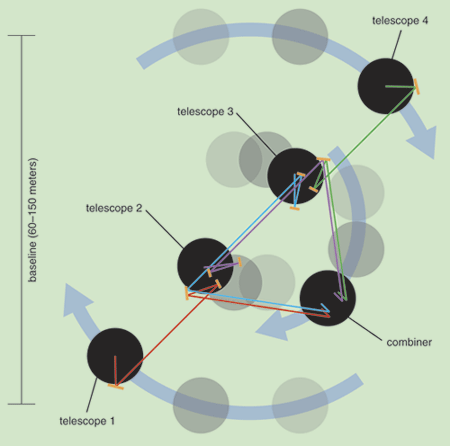
Barbara Aulicino
By April 2004 enough information had been developed on the relative strengths and weaknesses of these two designs that NASA administrators were prepared to make a final decision: Both designs will be pursued. The first to launch, a coronagraphic mission called TPF-C, will be scaled down from the versions initially studied. A smaller, simplified design was adopted to help ensure that a planet finder could be put in space within a decade or so. (The originally specified target date of 2014 has recently been delayed, but no new launch date has yet been established.) The second mission, a formation-flying interferometer called TPF-I, which will be capable of looking deeper into space than can TPF-C, is being planned for launch around six years after the coronagraph. TPF-I will be developed in collaboration with the European Space Agency, which had been working on its own design for a free-flying interferometer, called Darwin, since 1993.
JPL has formed a TPF-C team, which includes people from other NASA centers, universities and industry, and development is proceeding apace. The design that has emerged calls for essentially the largest primary mirror that can be fit into the 5-meter-diameter payload shroud of the rocket that will launch it into space, Boeing's Delta IV-H. The elliptical 8-by-3.5-meter mirror has more than four times the collecting area of Hubble's primary mirror but weighs only 30 percent more. Optimum performance of the coronagraph requires that the light path be unobstructed by the secondary mirror, so the primary mirror will be mounted at an angle and the secondary will be positioned on a 12-meter-high tower alongside, making for an off-axis optical system. A third mirror directs the light from the secondary to the coronagraphic optics and the scientific instruments, which will be tucked behind the primary.
The future TPF-C instrument will improve on the Hubble telescope in the way it deals with pointing jitter, erratic motions that smear out fine details in the images obtained. In TPF-C, these movements will be minimized by isolating the telescope itself from the spacecraft and its many moving parts—rotating solar arrays (which provide power), a solar sail (which counteracts torques arising from the pressure of sunlight), spinning reaction wheels (used to orient the telescope) and moveable high-gain antennas (for beaming signals back to Earth).
Like the coronagraph of the Lyot Project, TPF-C will use deformable mirrors to correct image distortions, which in this case can be anticipated to arise from imperfections or misalignments of optical surfaces, not from vagaries of the atmosphere. Engineers estimate that the shapes of the primary and secondary mirrors can be held stable during on-orbit observations to within just a few angstroms.
The TPF-C project may employ advanced "shaped pupil" masks to combat the immense glare of the stars being probed. A relatively simple device of this type, designed by David N. Spergel and N. Jeremy Kasdin of Princeton University and called a prolate-spheroidal pupil mask, is an early version of one of the designs being considered for this purpose. In concert with the rest of the optics, this device can diminish glare by a factor of 10 billion in two regions on either side of a star. If such a design were used, the wedge shape and limited extent of these regions would require that the target star be observed at a number of "roll angles" about the line of sight so as not to miss a possible planet.
In addition to a set of imaging detectors, TPF-C will also carry a spectrograph, a yet-to-be-defined instrument (probably a wide-field camera) for general astrophysical observations and a fine-guidance camera, which is needed to control the pointing of the telescope. All will operate in the visible region of the spectrum and perhaps into the near-infrared. At these wavelengths, the light being detected is starlight reflected by the planet. Because by its nature a planet-seeking telescope is operating very close to a target star, the field of view of the coronagraphic camera will be only about 3.6 arc-seconds across; the field of view of the instrument intended for general astrophysics will be much larger, up to 4 arc-minutes wide.
NASA plans to launch TPF-C into a "halo orbit" about a special location in space: the Sun-Earth L2 Lagrangian point, which is 1.5 million kilometers from Earth in the direction away from the Sun. In such an orbit, the thermal and stray-light conditions are relatively benign, allowing long observing times. An innovative sunshade will protect the primary and secondary mirrors from incident sunlight and its attendant heating, while permitting almost all of the hemisphere oriented away from the Sun to be viewed. Thus any star in the sky will be visible for about six consecutive months.
The TPF-C mission will concentrate on looking for Earthlike planets around 35 carefully selected stars, with a goal to examine an additional 130 as scheduling permits. The coronagraph flown will be capable of detecting the spectral signature of oxygen, ozone and water, and it is hoped that carbon dioxide and methane will also be detectable.
Although deployment of a planet-finding interferometer is still far off—probably around 2020—investigations led by JPL are under way to define the most advantageous architecture for such an instrument and to develop the necessary technology. The preliminary configuration using four collector telescopes and one beam combiner remains the standard against which other designs with up to six collecting mirrors are being judged. The intended wavelength range for operations is from 7 to 17 micrometers in the mid-infrared, and the favored orbit is the halo orbit about the Sun-Earth L2 Lagrangian point, as for TPF-C.
The real challenge in planning for the interferometer mission lies in working out the many details. In particular, achieving and maintaining good interferometric nulls will require that the input beams be closely matched and that their path lengths be controlled to nanometer levels. Nulling will take place in a separate module, where the individual collector beams will be combined in pairs before these pairs will in turn be combined. Finally, the fully nulled output beam will be sent to various detectors for imaging and spectroscopy.
During searches for exoplanets, the distance between the two most widely spaced collecting modules will range from about 60 to 150 meters. Thus TPF-I will essentially have the resolution of a single 60- to 150-meter telescope. The two-dimensional images this interferometer will provide must, however, be built up by processing the varying planet signal as it moves in and out of a pattern of interference fringes while small thrusters rotate the entire constellation of spacecraft through 360 degrees about the line of sight to the target star.
Controlling the formation flight of the collector telescopes and combiner module to accuracies of about one centimeter, all the while maintaining precise beam alignment, remains one of the most demanding requirements. To help them grapple with this challenge, engineers at JPL are developing three robotic modules meant to simulate the motion of the TPF-I component spacecraft. These prototypes will eventually be set loose on a large air-bearing table, where they will be programmed to move autonomously in formation using thrusters and guidance hardware that mimic the equipment that will be deployed in space.
Engineers have their work cut out for them in tackling the challenges of precise formation flying, the alignment of the various light beams and the control of their path lengths. But accomplishing these technological feats offers a big payoff: long interferometer baselines and the commensurately high angular resolution they bring. TPF-I will thus be able to study more distant star systems than will TPF-C.
The current plan is for the interferometer to carry out planet-detection surveys of about 150 stars, to perform follow-up spectroscopy on up to 30 planets and then to investigate in greater detail half a dozen of the most promising for firmer evidence of biomarkers. From time to time the mission will also serve astronomers interested in other sorts of high-resolution astrophysical studies, for example, observations of star- and planet-forming molecular clouds, active galactic nuclei and starburst galaxies.
Although the launch dates for TPF-C and TPF-I are many years away and still quite uncertain, astronomers are already thinking hard about what the logical next step would be if these instruments are successful in finding promising Earthlike candidates. Two missions are in preliminary planning stages. The first, Life Finder, has as its aim to produce high-resolution spectra of the atmospheres of Earthlike planets, which will allow astronomers to look for terrestrial levels of subtle biomarker gases, such as methane or nitrous oxide. One configuration that has been considered is a scaled-up version of TPF-I, consisting of four 25-meter collector telescopes operating over an interferometric baseline that is up to 15 kilometers in length. Such a constellation would require roughly 1-month integration times to develop the requisite spectral resolution and sensitivity.
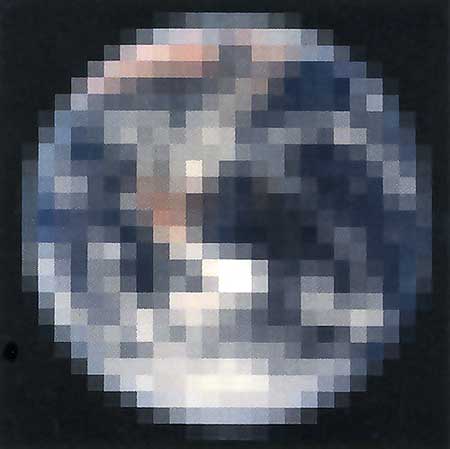
A second future mission, Planet Imager, is even more ambitious, having the goal to produce modestly rich images of planetary surface features and environs—oceans, land masses, clouds, moons and rings. In one concept, a constellation of twenty-five 40-meter coronagraphic telescopes flying in a 360-kilometer-diameter circular formation would send its images to a central spacecraft for combination and telemetry back to Earth. Working in visible light, such an array could be capable of producing a 25-by-25-pixel image of an Earth-size planet that is 33 light-years away.
But before making any such giant leaps into the future, investigators will have to take a lot of baby steps. Even before the two Terrestrial Planet Finder missions begin, astronomers will be keeping very busy perfecting their ground-based instruments for coronagraphy and nulling interferometry, as well as planning for the launch of technology-proving space missions such as the James Webb Space Telescope. But no doubt in the back of their minds will be the awe-inspiring possibility of some day actually seeing the likeness of a far-flung Earthlike world.
Click "American Scientist" to access home page
American Scientist Comments and Discussion
To discuss our articles or comment on them, please share them and tag American Scientist on social media platforms. Here are links to our profiles on Twitter, Facebook, and LinkedIn.
If we re-share your post, we will moderate comments/discussion following our comments policy.